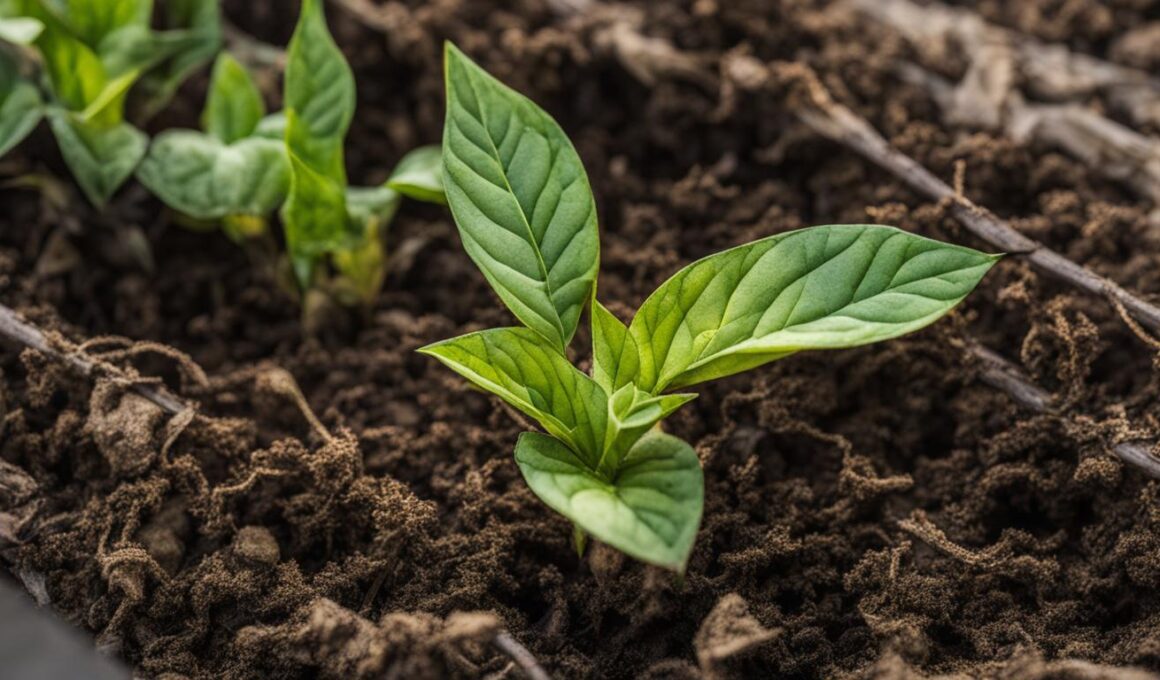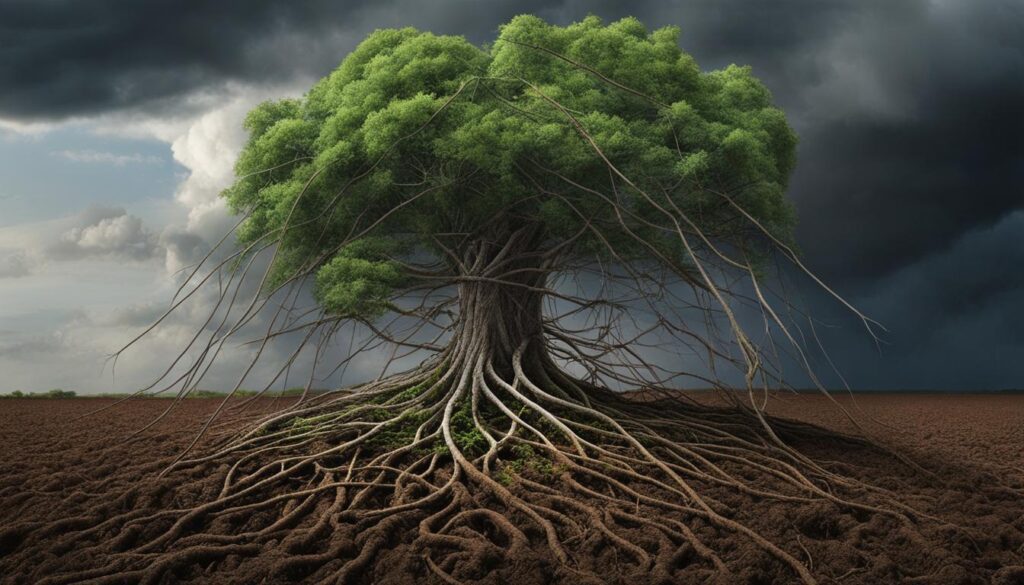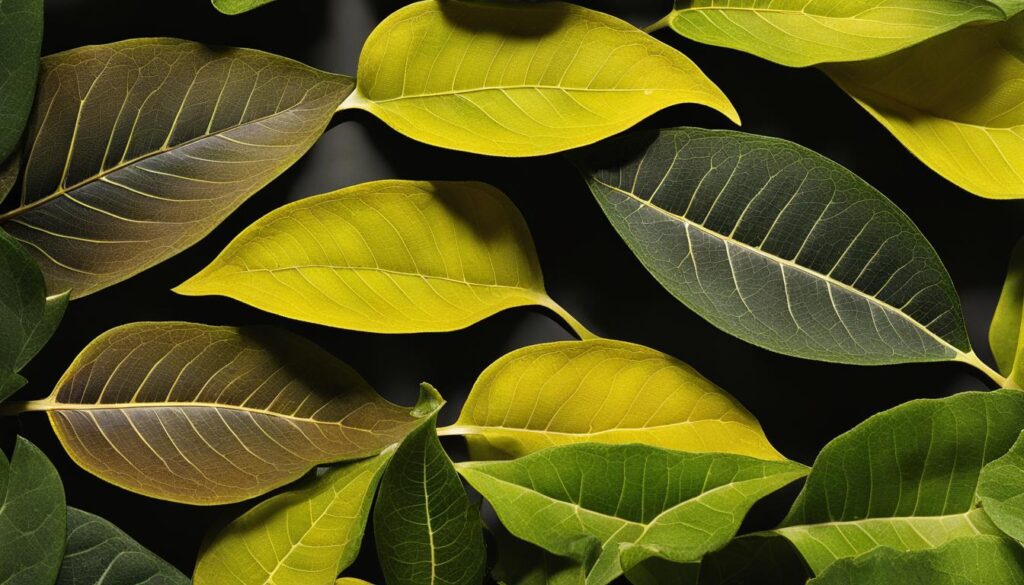Iron deficiency in plants can have detrimental effects on their health and growth. It is important to be able to identify the symptoms of iron deficiency in order to address the issue promptly. In this guide, we will explore the key signs to look out for, helping you become adept at spotting iron deficiency in your plants.
Key Takeaways
- Iron deficiency in plants can lead to discoloration or premature dying of leaves, stunted growth, blemishes on fruits, and undeveloped root systems.
- Differentiating iron deficiency symptoms from other causes is crucial, such as pests, disease, salinity, herbicide drift, physiological conditions, and environmental conditions.
- Mobile nutrients like nitrogen, phosphorus, potassium, and magnesium show symptoms on older leaves, while immobile nutrients like iron, zinc, calcium, and boron show symptoms on growing tips.
- Factors affecting nutrient uptake in plants include nutrient availability, soil pH, soil structure, water availability, root health, and environmental conditions.
- Common nutrient deficiencies in plants include nitrogen, phosphorus, potassium, magnesium, iron, manganese, zinc, calcium, sulfur, and boron.
Factors Affecting Nutrient Uptake in Plants
When it comes to nutrient uptake in plants, there are several factors that can influence the process. Understanding these factors is essential for diagnosing and addressing nutrient deficiencies in your plants.
One crucial factor is nutrient availability in the soil. Some soils naturally lack certain nutrients, making it challenging for plants to take them up effectively. Additionally, soil pH plays a significant role in nutrient availability. Extreme acidity or alkalinity can hinder the availability of essential nutrients, leading to deficiencies.
Soil structure also affects nutrient uptake. Loamy or clayey soils have better water and nutrient retention capabilities compared to sandy soils. Consequently, plants growing in loamy or clayey soils may have better access to nutrients.
Water is another critical factor for nutrient uptake. Both underwatering and overwatering can impact the ability of plants to absorb nutrients. Maintaining proper watering practices is crucial to ensure optimal nutrient uptake and prevent deficiencies.
Environmental conditions and root health
Environmental conditions, such as temperature extremes, can also affect nutrient uptake in plants. While some plants may exhibit reduced nutrient absorption in extreme temperatures, others may thrive. Understanding the specific needs of your plants is essential for providing the right conditions for optimal nutrient uptake.
Healthy and well-developed roots are crucial for efficient nutrient uptake. Damaged or diseased roots may struggle to absorb nutrients effectively, leading to deficiencies in the plants. Regular monitoring and care of the root system are vital for promoting nutrient uptake and preventing deficiencies.
By considering these factors and implementing proper fertilization practices, you can support the nutrient uptake process in your plants and ensure their optimal growth and development.
| Nutrient Uptake Factors | Impact on Nutrient Uptake |
|---|---|
| Nutrient Availability in Soil | Determines the accessibility of essential nutrients for plant uptake |
| Soil pH | Extreme acidity or alkalinity can hinder nutrient availability |
| Soil Structure | Loamy or clayey soils retain more water and nutrients compared to sandy soils |
| Water | Both underwatering and overwatering can impact nutrient uptake |
| Environmental Conditions | Temperature extremes can affect nutrient absorption in plants |
| Root Health | Healthy and well-developed roots are crucial for efficient nutrient uptake |
Common Nutrient Deficiencies in Plants
Plants can experience various nutrient deficiencies, which can affect their overall health and growth. Understanding these common deficiencies is crucial for maintaining vibrant and thriving plants. Here are some of the most prevalent nutrient deficiencies in plants:
- Nitrogen: Plants lacking nitrogen may exhibit pale, yellowish-green leaves and stunted growth.
- Phosphorus: A deficiency in phosphorus can cause reddish-purple coloration on older leaves.
- Potassium: Plants lacking potassium may develop leaf edge chlorosis and interveinal scorching.
- Magnesium: A deficiency in magnesium can result in interveinal chlorosis on older leaves.
- Iron: Iron deficiency often manifests as pale green or yellow interveinal chlorosis, particularly on newer leaves.
- Manganese: Plants lacking manganese may display yellowing between the veins of new foliage.
- Zinc: A deficiency in zinc can cause interveinal light striping or a whitish band on younger leaves.
- Calcium: Plants lacking calcium may exhibit stunted growth, leaf curling, and tip burn.
- Sulfur: A deficiency in sulfur can lead to general yellowing of foliage.
- Boron: Plants lacking boron may show stunted growth, cupped or puckered leaves, and witches broom-like side shoots.
Why are These Nutrients Important?
Each of these nutrients plays a vital role in the growth and development of plants. Nitrogen is essential for leaf and stem formation, while phosphorus promotes root development and flowering. Potassium helps regulate water balance and overall plant health. Magnesium is a key component of chlorophyll, which is crucial for photosynthesis. Iron, manganese, zinc, and calcium are involved in various enzymatic processes and overall plant metabolism. Sulfur is important for protein synthesis, and boron is necessary for pollen tube growth and cell wall formation.
When plants lack these essential nutrients, they are unable to perform their normal physiological functions efficiently, resulting in various visible symptoms. By understanding and addressing these common nutrient deficiencies, gardeners and plant enthusiasts can promote optimal plant growth and health.
Mobile and Immobile Nutrients in Plants
Understanding the mobility of nutrients in plants is crucial for diagnosing and addressing nutrient deficiencies. Nutrients can be classified as either mobile or immobile, depending on their ability to move within the plant. Mobile nutrients, such as nitrogen, phosphorus, potassium, and magnesium, are readily translocated to different parts of the plant, allowing them to be redistributed when deficiencies occur. Deficiency symptoms of these mobile nutrients often appear on older leaves, which serve as nutrient reservoirs for the growing plant.
On the other hand, immobile nutrients, including iron, zinc, calcium, and boron, are not easily transported within the plant. As a result, deficiencies of these nutrients primarily manifest in the younger, actively growing parts of the plant, such as the leaf tips and developing shoots. It is important to note that the symptoms of nutrient deficiencies can vary depending on the specific nutrient and the plant species.
To accurately diagnose nutrient deficiencies, it is essential to consider the mobility of nutrients. By closely observing the location of deficiency symptoms, gardeners and plant enthusiasts can determine whether the issue is related to mobile or immobile nutrients. This information can guide the proper treatment and fertilizer application to address the deficiency and ensure optimal plant growth and development.
Factors Influencing Nutrient Mobility
The mobility of nutrients within plants is influenced by various factors. One key factor is the solubility of the nutrient in water. Mobile nutrients, which are more soluble, can be easily transported through the plant’s vascular system. Conversely, immobile nutrients have lower solubility and are less easily transported.
The structure of the plant also plays a role in nutrient mobility. Nutrients are transported via the xylem and phloem, which are vascular tissues responsible for water and nutrient movement. Plants with well-developed vascular systems are able to efficiently transport nutrients throughout their tissues.
Additionally, the physiological characteristics of different plant species can affect nutrient mobility. Some plants have mechanisms to enhance the translocation of certain nutrients, while others may have limited mobility for specific nutrients. Understanding these factors can help in the diagnosis and management of nutrient deficiencies in plants.
| Nutrient | Mobility | Symptoms of Deficiency |
|---|---|---|
| Nitrogen | Mobile | Pale, yellowish-green leaves; stunted growth |
| Phosphorus | Mobile | Reddish-purple coloration on older leaves |
| Potassium | Mobile | Leaf edge chlorosis; interveinal scorching |
| Magnesium | Mobile | Interveinal chlorosis on older leaves |
| Iron | Immobile | Pale green or yellow interveinal chlorosis |
| Zinc | Immobile | Interveinal light striping or whitish band on younger leaves |
| Calcium | Immobile | Stunted growth; leaf curling; tip burn |
| Boron | Immobile | Stunted growth; cupped or puckered leaves; witches broom-like side shoots |
Conclusion
Iron deficiency symptoms in plants, such as pale green or yellow interveinal chlorosis on new leaves, can be easily identified. By understanding the factors affecting nutrient uptake and recognizing common nutrient deficiencies, you, as a gardener or plant enthusiast, can effectively diagnose and address iron deficiency in your plants.
To ensure your plants receive the necessary nutrients, it is important to implement proper fertilization practices. Balanced fertilizers and controlled release fertilizers can provide essential nutrients to your plants. However, in severe cases of iron deficiency, specific nutrient supplements or foliar sprays may be required to revive the vibrancy and vigor of your plants.
By being vigilant and proactive in spotting and addressing iron deficiency symptoms, your plants can thrive and flourish. Regular observation and diagnosis of nutrient deficiencies will help you maintain healthy and vibrant plants in your garden or indoor space.
FAQ
What are the visible symptoms of iron deficiency in plants?
Iron deficiency in plants can cause discoloration or premature dying of leaves, stunting of growth, blemishes on fruits, and undeveloped root systems.
How can I differentiate iron deficiency symptoms from other potential causes?
It is important to consider other potential causes such as pests, disease, salinity, herbicide drift, physiological conditions, and environmental conditions to accurately diagnose iron deficiency symptoms in plants.
Which nutrients show deficiency symptoms on older leaves?
Mobile nutrients like nitrogen, phosphorus, potassium, and magnesium show deficiency symptoms on older leaves.
Which nutrients show deficiency symptoms on growing tips?
Immobile nutrients like iron, zinc, calcium, and boron show deficiency symptoms on growing tips.
What factors can affect nutrient uptake in plants?
Nutrient availability, soil pH, soil structure, water availability, plant root health, and environmental conditions such as temperature extremes can impact nutrient uptake in plants.
What are some common nutrient deficiencies in plants?
Common nutrient deficiencies in plants include nitrogen, phosphorus, potassium, magnesium, iron, manganese, zinc, calcium, sulfur, and boron.
How can I address nutrient deficiencies in plants?
Proper fertilization practices, including the use of balanced fertilizers and controlled release fertilizers, can help address nutrient deficiencies in plants. In severe cases, specific nutrient supplements or foliar sprays may be required.
How can I identify iron deficiency symptoms in plants?
Iron deficiency symptoms in plants can be identified by the appearance of pale green or yellow interveinal chlorosis on new leaves.
What should I do if I spot iron deficiency symptoms in my plants?
By being vigilant and proactive in spotting and addressing iron deficiency symptoms, you can take steps such as proper fertilization practices and the use of nutrient supplements or foliar sprays to help revive the vibrancy and vigor of your plants.
How does iron deficiency in plants differ from excess iron in plants, and how can I identify and treat these issues in my plants?
Iron deficiency in plants can lead to yellowing of leaves and stunted growth, while excess iron symptoms in plants may include leaf bronzing or darkening. To identify and treat these issues, monitor plant growth and leaf color, and adjust soil pH and drainage as needed to balance iron levels.











